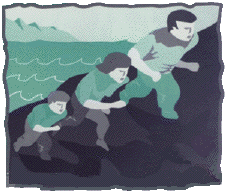Tsunami Hazard Mitigation
Information about tsunamis that may SAVE YOUR LIFE
The following material is excerpted from Tsunami! The Great Waves

In general, if you think a tsunami may be coming, the ground shakes under your feet or you hear there is a warning, tell your relatives and friends, and move quickly to higher ground.
To learn more about how you can protect yourself from tsunamis, review the following sections:
Important Facts to Know about Tsunamis
- Tsunamis that strike coastal locations in the Pacific Ocean Basin are most always caused by earthquakes. These earthquakes might occur far away or near where you live.
- Some tsunamis can be very large. In coastal areas their height can be as great as 30 feet or more (100 feet in extreme cases), and they can move inland several hundred feet.
- All low-lying coastal areas can be struck by tsunamis.
- A tsunami consists of a series of waves. Often the first wave may not be the largest. The danger from a tsunami can last for several hours after the arrival of the first wave.
- Tsunamis can move faster than a person can run.
- Sometimes a tsunami causes the water near the shore to recede, exposing the ocean floor.
- The force of some tsunamis is enormous. Large rocks weighing several tons along with boats and other debris can be moved inland hundreds of feet by tsunami wave activity. Homes and other buildings are destroyed. All this material and water move with great force and can kill or injure people.
- Tsunamis can occur at any time, day or night.
- Tsunamis can travel up rivers and streams that lead to the ocean.
If you are on land:
- Be aware of tsunami facts. This knowledge could save your life! Share this knowledge with your relatives and friends. It could save their lives!
- If you are in school and you hear there is a tsunami warning, you should follow the advice of teachers and other school personnel.
- If you are at home and hear there is a tsunami warning, you should make sure your entire family is aware of the warning. Your family should evacuate your house if you live in a tsunami evacuation zone. Move in an orderly, calm and safe manner to the evacuation site or to any safe place outside your evacuation zone. Follow the advice of local emergency and law enforcement authorities.
- If you are at the beach or near the ocean and you feel the earth shake, move immediately to higher ground, DO NOT wait for a tsunami warning to be announced. Stay away from rivers and streams that lead to the ocean as you would stay away from the beach and ocean if there is a tsunami. A regional tsunami from a local earthquake could strike some areas before a tsunami warning could be announced.
- Tsunamis generated in distant locations will generally give people enough time to move to higher ground. For locally-generated tsunamis, where you might feel the ground shake, you may only have a few minutes to move to higher ground.
- High, multi-story, reinforced concrete hotels are located in many low-lying coastal areas. The upper floors of these hotels can provide a safe place to find refuge should there be a tsunami warning and you cannot move quickly inland to higher ground. Local Civil Defense procedures may, however, not allow this type of evacuation in your area. Homes and small buildings located in low-lying coastal areas are not designed to withstand tsunami impacts. Do not stay in these structures should there be a tsunami warning.
- Offshore reefs and shallow areas may help break the force of tsunami waves, but large and dangerous wave can still be a threat to coastal residents in these areas. Staying away from all low-lying areas is the safest advice when there is a tsunami warning.
If you are on a boat:
Since tsunami wave activity is imperceptible in the open ocean, do not return to port if you are at sea and a tsunami warning has been issued for your area. Tsunamis can cause rapid changes in water level and unpredictable dangerous currents in harbors and ports.
If there is time to move your boat or ship from port to deep water (after a tsunami warning has been issued), you should weigh the following considerations:
- Most large harbors and ports are under the control of a harbor authority and/or a vessel traffic system. These authorities direct operations during periods of increased readiness (should a tsunami be expected), including the forced movement of vessels if deemed necessary. Keep in contact with the authorities should a forced movement of vessel be directed.
- Smaller ports may not be under the control of a harbor authority. If you are aware there is a tsunami warning and you have time to move your vessel to deep water, then you may want to do so in an orderly manner, in consideration of other vessels. Owners of small boats may find it safest to leave their boat at the pier and physically move to higher ground, particularly in the event of a locally-generated tsunami. Concurrent severe weather conditions (rough seas outside of safe harbor) could present a greater hazardous situation to small boats, so physically moving yourself to higher ground may be the only option.
- Damaging wave activity and unpredictable currents can effect harbors for a period of time following the initial tsunami impact on the coast. Contact the harbor authority before returning to port making sure to verify that conditions in the harbor are safe for navigation and berthing.
![[Help]](/tsunami/images/help.gif)
![[Table of Contents]](/tsunami/images/tcarrow.gif)
![[Help]](/tsunami/images/help.gif)
![[Table of Contents]](/tsunami/images/tcarrow.gif)